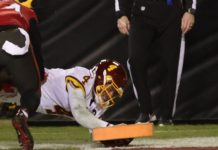Just a few days before Naomi Osaka, the defending champion of the United States Open, stepped onto the court at Arthur Ashe Stadium in Flushing, Queens, for her first match of the 2021 tournament, the four-time Grand Slam title winner made another stop in Queens: to an unassuming public park in Jamaica.
There, at Detective Keith L. Williams Park, Ms. Osaka attended the unveiling of five renovated tennis courts with new nets and surfaces, all of which are surrounded by newly painted graphics and symbols. With funding from Bodyarmor, the sports drink company based in Whitestone, Queens, Ms. Osaka served as a creative and practical adviser on how to refurbish the tennis courts.
After all, it was personal for her.
Ms. Osaka, whose father is Haitian and mother is Japanese (and who represents Japan when she competes), was 3 years old when her family left Osaka, Japan, for Elmont, a hamlet on Long Island near the Queens border. Soon after, her father started to bring Naomi and her older sister, Mari, to the Jamaica courts because they were free and inclusive. The sisters learned how to play tennis there. Naomi went on to become the No. 1 player in the world in 2019.
“As a traveling athlete, the place that always feels like home is Queens and these courts,” said Ms. Osaka, who played tennis in Jamaica until her family left the area for Pembroke Pines, Fla., when she was 8. “Mari and I spent so much time here as kids, so many hours on these courts, practicing, and we really feel a connection to not only the courts but the area and the community.”
Before Ms. Osaka visited either court in Queens, whether it was in a stadium or a public park, The Times caught up with her over email. The following is an edited and condensed version of the interview.
Q. How did you end up playing tennis in Jamaica?
A. It was really expensive to practice at indoor clubs or any other court for that matter, especially considering how many hours we were usually on the court practicing. So my parents started taking me to play in Jamaica because that was all we really had as an option.
What memories do you have from these courts?
My dad was always coaching me and Mari. We mostly did drills, but I remember hitting with some of the local players, men who were anywhere from 30 to 50 years old. Because we were there so often, everyone knew who we were, and there was a sense of community. When I first started playing I remember some of them enjoyed kicking our butts. But as I got older, I could put up a fight against some of them. I remember one of them, he was tall and lanky. I started beating him too much, so my dad gave me certain rules to follow, like always hit the ball at him so he doesn’t have to move or start every game down 0-30.
Do you have any vivid New York memories from then?
On the weekends my mom would bring us into the city and take us into Chinatown, and we got this hot, fluffy scallion bread. I have no idea which specific shop it was, but it’s my favorite food, and I think about it when I think about New York City.
It can be hard to find a tennis court in the city. Many have steep fees or long lines. How would you like to see this one operate?
I would love to see people from the community play on this court, people who don’t necessarily have the means to pay for a club membership, people who just want to try and hit some balls for the fun of it, or kids who are trying to reach a dream. When we were young we got kicked off so many courts because we stayed too long or didn’t pay enough money. I wish for these courts to just let anyone play on a first come first served basis.
When you refurbished the courts you left a lot of symbols on them. Tell us about their meaning.
Not only did I want to create a really cool court that kids could relate to and want to come see and play on, we wanted to leave behind a message that would hopefully inspire the community, especially the kids. So Mari, who is an amazing artist, and I collaborated on a mural that ties in some of our personal background as well as places and symbols.
As you enter the court you’ll see a welcome sign in English, Haitian and Japanese, which represents our background. Music is also a huge part of my life, it’s my pre-match ritual, so you’ll see music notes painted on the edge of the court. There is also a trophy on one end to acknowledge my career and inspire others to reach their goals. Peace is incredibly important to me off the court, so you’ll see symbols of that. While the colors we used on the court are bright, they are also cool and calming. I’m a big fan of blues and purples.
Would you be interested in developing other courts and programs in other underserved neighborhoods across the country?
I am already working on a bunch of similar projects with my foundation, the Play Academy. We want to create opportunities for girls to have positive experiences with play and sport in the United States, Japan and Haiti. My parents also built tennis courts (as part of a school) in Jacmel, Haiti. My dad has family there, and it is not too far from the capital, which made it a convenient location.
At the end of the day I just hope everyone remembers that tennis is a game and is meant to be fun.
Source : NYtimes













